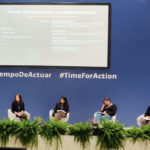Transport, Gender and Climate Action – A Young Leader’s experience of COP25
By Seema Singh
Last December, I had the opportunity to attend the UN Climate Change Conference COP25 (25th meeting of the Conference of the Parties to the United Nations Framework Convention on Climate Change (UNFCCC)) with the SLOCAT Partnership delegation, through its programme for Young Leaders in Sustainable Transport (YLST). Launched jointly by SLOCAT and Volvo Research and Educational Foundations (VREF) in June 2019, YLST aims at building bridges between the transport community and young people, and bringing in new perspectives into transport policymaking processes and practices. In its first batch, YLST recognised six young professionals from different backgrounds, and I was honoured to be among them.
My involvement at COP25
COP can be a bit overwhelming for a first-timer. One finds oneself in a seamless sequence of long days running around from room to room, pavilion to pavilion, event to exhibit, negotiation session to press conference amidst 25,000 other people. As a sustainable transport enthusiast, the highlights for me were mostly divided between the vast array of side events (including plenaries, action hub events, pavilion events) and exhibits – connected by the common theme of transport and climate action.
In light of UNFCCC’s increased efforts in pushing for the inclusion of gender matters in climate action deliberations and my ongoing doctoral research on gender and sustainable transport linkages, I was particularly interested in observing the engagement of the transport community at the global level around ‘gender differences in transport needs’. With the support received from the SLOCAT Secretariat team, I had the opportunity of organising and moderating a panel discussion (Action Hub event) jointly led by SLOCAT and the International Transport Forum (ITF)) on gender and sustainable transport, with participants from Costa Rica, Europe, Colombia, and India. Moreover, COP25 was an opportunity for me to see first-hand, understand, and participate in the inner functionings of facilitating the engagement of the sector at COP. The experience brought forward the many difficulties that arise in reconciling scientific findings, policymaking, and geopolitics in the transport sector. From bringing together leaders from different parts of the world, to coming up with common themes and goals cutting across the regional differences, from staying updated on exciting events, conversations, new political announcements or even climate deals being signed on a daily or even hourly basis, to ensuring the success of your own events and to making sure your social media audience also stays updated with the daily sectoral news – are only some of the challenges faced by anyone participating at a global event like COP.
Transport and climate action
In 2020, countries are due to update their Nationally-Determined Contributions (NDCs), and it is widely accepted that they must significantly ramp up their mitigation ambition to reach a 1.5ºC target. To meet this threshold, emissions would have to be cut by 45% by 2030, which would require an unprecedented global transition away from fossil fuels.
Given the dominating trend of excessive contribution to global energy-related GHG emissions from transport, the transition to transport decarbonisation is central to COP25 negotiations. The reality, however, is that while 76% of the NDCs under the Paris Agreement mention transport as relevant for CO2 mitigation and more than 60% evoke transport-related measures, less than 10% of NDCs set a quantified CO2 reduction target for the transport sector.
- Expectations from the transport sector at COP25 included expansion upon a number of key negotiation topics, such as:
- Increased commitments to raise transport decarbonisation ambition and action in next NDCs through science-based targets;
- Adoption of the Paris Rulebook, with resolution on Article 6 on carbon markets and common timeframes;
- Strengthened linkages between gender and effective transport climate action;
- Increased resilience and adaptation action for transport systems worldwide;
- Open support across countries towards the extension of the mandate of the Marrakech Partnership for Global Climate Action, the platform that articulates collaborative dialogue and action between so-called parties (Member States to the Paris Agreement) and non-parties.
I approached COP25 deliberations with these expectations in mind. On the one hand, it was heartening and encouraging to witness how far the transport community has come in terms of identifying the broader implications of transport-related decisions, and how the community stood together at a global level to set achievable carbon reduction goals. On the other hand, it was a reflective moment for me on several grounds, particularly in terms of identifying challenges and gaps in the overall transport and climate action agenda, and the many challenges that the transport community continues to face in absolute realisation of a carbon-neutral future.
Below are some reflections on these challenges and gaps – It is in no way the only or an exhaustive list of what the transport community must address going forward:
o Goal setting vs. Implementation: Remarks by panelists at Transport Day involved broad statements, full of ambitious plans around cutting emissions from the transport sector, while paid insufficient attention to the specific barriers/challenges faced in implementing them.
A dedicated session on ‘Barriers to transition’ at Transport Day was helpful in getting people to talk about what restricts the kind of change the transport community envisions and confirmed that much more discussion on the specific elements of technological and financial barriers is needed. This raises important questions in terms of how specific can one get in a high-level gathering like COP, where overall formats and schedules are constraining and do not favour in-depth conversations. Without the specifics, how far can we go by reiterating some of these widely accepted and established common goals and strategies such as – improve public transport, shift to cleaner fuels, promote sustainable modes, so on and so forth?
o Raising ambition vs. Accountability: Closely linked to the above and as a must-do in the reality of climate urgency we are living, is the challenge of increasing commitments to raise transport ambition and action in the next NDCs through science-based targets. However, without adequate mechanisms for the accountability of national and sub-national government in their ambitions, progress remains uncertain and abstract.
o Common timeline vs. Regional differences: Different countries or regions have different development trajectories, and different transport investment needs mostly defined by their socio-economic and geographical contexts. For example, while low income and emerging economy countries highlight at COP their struggles with basic infrastructure and capacity issues, the Global North focuses on improving system efficiency and transitioning to newer fuels and technologies. Now, this raises the question – who calls the shots here? With the constant risk of higher representation from Global North nations at COP panels and audience, I found the conversations to be overall unbalanced and neglecting the transport issues and challenges faced by the Global South. For example, informal and/or paratransit modes fulfill the majority of transport demand in Global South cities but this is not a topic COP delegates would be discussing at all. Once again raising questions about – how do you bridge this Global North vs Global South gap? And how does one then find common ways of following or committing to a common timeframe?
o Sectoral linkages and gaps: Focusing in isolation on specific transport modes and/or on transport as a sector, without thorough attention to its linkages to other areas (like energy, land use, other transport modes) means that we are missing the forest (bigger picture) by focusing on trees (small pieces or specifics). While it is understandable that in the given format of these global conferences some divisions are important (for example shipping and air transport needs separate attention); it is important to reflect on what we are missing by separating interconnected sectors in separate rooms. How and when do we come together to feed into each other and close the gaps?
o Environment vs. Equity: Too much focus on carbon reduction with limited or no attention to other interrelated goals like access and equity highlights the inadequacy of the current siloed thinking. In addition, much work remains ahead of us to increase resilience and enable the adaptation of the current transport systems and infrastructure worldwide.
Bringing gender into the transport and climate action agenda
Pre-COP25 held in October 2019 in Costa Rica brought attention to gender and climate action linkages as an essential cross-cutting theme. Gender, along with intersecting inequalities (e.g., income, age, ethnicity, (dis)ability) can often determine a person’s access to transport, and thus, access to jobs and socio-economic opportunities. Designing transformative adaptation strategies keeping in mind the gender differences in transport needs, as well as adaptive capabilities, is therefore central to realising a climate-resilient, more gender-equal world.
Attending some COP25 gender and transport events made me realise that it is just the beginning, and there is a long way to go to effectively address and mainstream gender concerns into transport policies and planning processes. For that to happen, it is crucial that sustainable, low carbon transport advocates and those advocating for gender inclusiveness come together in the same room, which was currently not the case. While transport-related events continued to be male-dominated, gender panels and events were mostly women dominated, and women-led. This also includes the all-women panel at the action hub event jointly organised by SLOCAT Partnership and ITF that I was a part of. Apart from encouraging gender balance in transport events, the deliberations, goals, and conversations need to pay more attention to how the current processes, by adopting a gender-neutral stance, lead to creation of different forms of social exclusion. There is a dire need to relook at transport planning methodologies and models to capture gender differences and account for women-specific travel needs (such as, mobility of care, trip chaining, safety and security issues, accessibility concerns, etc.).
Seema is a Ph.D. Candidate in the Department of City and Regional Planning at Cornell University, USA. Her dissertation work aims to examine gender and urban transport linkages in India with the key intent of mainstreaming gender concerns in urban planning and policymaking in developing country context.

